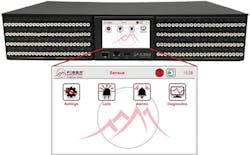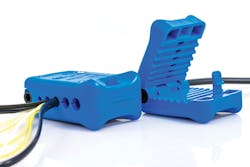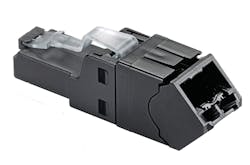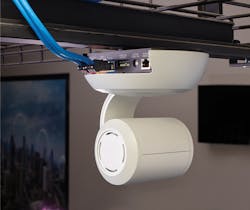FIBER OPTICS
AFL unveils FOCIS Duel fiber inspection microscope
AFL says its new FOCIS Duel fiber inspection microscope delivers advanced LC connector analysis performance to minimize fiber handling operating costs. Launched at the BICSI Winter Conference & Exhibition 2018, the “field-ready, straightforward FOCIS Duel is the world’s first fiber inspection probe with two optical ports,” AFL asserts. With one port enhanced for fast subjective patch-cord endface inspection, the second port supports all the features of AFL’s FOCIS Flex inspection system, which the company launched in 2014.
The FOCIS Duel features female “plug-in” fiber-optic connector adapters for rapid endface inspection operation, and LC adapters to mechanically accommodate the duplex LC connectors typically used in data centers. With no moving parts and no operator adjustments needed to provide automatic image analysis to industry standards and custom criteria, FOCIS Duel supports time-sensitive, rugged environments, says AFL.
The FOCIS Duel can be used for field testing, standards-compliant analysis, record archiving, and network management. The tool’s Bluetooth transceiver interworks with AFL’s FOCIS app for Android and iOS smart phones and tablets. Offering connectivity to AFL’s aeRos cloud-based workflow management platform, the FOCIS app offers pinch-to-zoom capability on endface images, clear tabular presentation of inspection results, image and report sharing by email and text, and other features.
According to AFL, fiber-optic network owners and maintenance contractors can reduce operating expenses via the FOCIS Duel’s 2.4-inch TFT LCD display, six soft buttons, straightforward GUI, instant on button, and lightweight form factor, all of which enable significant productivity. UPC and APC adapters, auto-focus, auto-capture, auto-analysis to IEC and IPC rules, image saving, image/tabular data/pass/fail results transfer over Bluetooth, and PDF report generation round out the unit’s operating features.
INTERNET OF THINGS
Comcast extends Internet-of-Things service, machineQ, based on LPWAN, LoRaWAN technologies
Comcast recently announced new business customers, ranging from Fortune 1000 enterprises to emerging startups, for its enterprise Internet of Things (IoT) service, machineQ, billed as a scalable IoT network service and platform that uses Low Power Wide Area Network (LPWAN) technology to build enterprise-grade solutions for businesses and municipal organizations. The service is deployed using the globally adopted LoRaWAN protocol.
According to a press release, using Comcast’s machineQ as their LoRaWAN-based wireless connectivity platform, the IoT solution providers listed below are now enabling their end users to make better-informed, data-based decisions.
Adveez – This IoT hardware and software solutions provider monitors businesses’ critical assets at airports, seaports and in cities with the goal of providing actionable data to locate and manage assets dynamically, reducing costs. Using machineQ’s LoRaWAN-based service, Adveez provides customers with a strong communications backbone to deploy asset tracking in expansive areas like cities, as well as the flexibility to manage small, more contained tracking applications in commercial storage yards.
CareBand – This wearables manufacturer is dedicated to reducing injuries to seniors due to dementia-related wandering by providing real-time, precise location tracking. CareBand provides location tracking both indoors and outdoors, and automated analysis of activity patterns to help caregivers identify early changes in condition. With machineQ’s network, the company is now capable of delivering this vital information across wide geographies and in dense urban environments.
Neptune – A software and hardware provider to the water industry, serving more than 4,000 utilities across North America, Neptune’s new, LoRa-enabled L900 series of water endpoints provides a wide range of capabilities for water meter reading and sensor applications that demand low-power consumption and long-range connectivity. By leveraging machineQ’s LoRaWAN-based network, Neptune is equipped with a connectivity solution to help water utilities boost efficiencies and accelerate sustainability efforts at the best possible total cost of ownership.
Pansofik – This developer of cost-effective, digital solutions helps SMBs and building owners integrate IoT and data analytics within their organizations. Leveraging the machineQ platform and LoRaWAN networking technology, the company has created a suite of environmental and energy monitoring sensor solutions that deliver enterprise-level security, service, and availability at a price point previously unattainable using existing systems.
Victor – A world leader in rodent control and a trusted brand name since 1898, Victor, a Woodstream Corporation brand, revolutionized the rodent control market over 100 years ago with the invention of the spring-based Victor Mouse Trap. Using LoRaWAN-based sensor technology operating on the machineQ network, the company is now enabling a new generation of capabilities and cost-effective pest control solutions that can be deployed across enterprises and within cities.
“IoT solution providers are seeking secure, reliable and highly scalable network connectivity, device management capabilities, and new IoT microservices, like geolocation, to speed their time-to-market. Our new customers have chosen machineQ because it can be deployed across a wide range of different enterprise use cases,” says Alex Khorram, general manager of machineQ. “We want IoT solution providers to know that we can handle their network needs, so they can focus on bringing their innovative solutions to market to the benefit of their end users.”
WIRELESS
CommScope launches ‘Era,’ all-digital C-RAN antenna system streamlining 5G in-building wireless deployments
CommScope Era, the company’s newly launched next-generation in-building wireless platform, is an all-digital C-RAN antenna system designed to leverage wireless operators’ initiatives to centralize and virtualize baseband radio assets. Intended as a foundational design concept for 5G networks, CommScope says the Era system “enables operators to deploy a centralized headend that serves multiple buildings, or even to tap capacity from the operator’s existing C-RAN hubs.”
Per a company press release, “Era enables operators to deploy a centralized headend that serves multiple buildings, or even to tap capacity from the operator’s existing centralized radio access network (C-RAN) hubs. Era’s innovative wide-area integration node (WIN) resides in the C-RAN hub and routes baseband capacity to a distribution point within the served building or campus. Era allocates baseband capacity where it is needed while reducing the amount of onsite headend equipment and the amount of fiber needed for signal transport by up to 90 percent.”
“We have invested heavily to create an all-digital platform architecture that upends the economics of in-building wireless and ushers in a new era and standard for distributed antenna systems,” contends Matt Melester, senior vice president, distributed coverage and capacity solutions, CommScope. “CommScope Era will be a key enabler for network densification in LTE Advanced, Gigabit LTE and 5G.”
CommScope holds 164 patent families for the technological innovations incorporated in Era. Melester adds, “Era’s all-digital architecture enables capabilities that analog DAS simply cannot. Capacity reallocation, soft resectorization, system setup and diagnostics are all software functions in Era, capable of being changed with a few clicks of a mouse. Era also transports Gigabit Ethernet backhaul to each remote node, which can be used for separate WiFi networks, IP security systems or to support a small cell overlay needed for future network expansion.”
The Era product line features a new family of access points that are available in a range of power levels, with copper and fiber connectivity and outdoor and plenum ratings, to serve a wide variety of venue types. It supports interleaved MIMO (multiple input/multiple output) using patented technology that can offer up to 80 percent of collocated MIMO speeds over a SISO (single input/single output) infrastructure. Era uses IT-standard copper and fiber-optic infrastructure and allows for the sharing of existing fiber networks, significantly reducing fiber costs.
“New systems like CommScope Era respond to operators’ needs for options that will make in-building wireless more affordable for building owners and commercial real estate companies,” asserts Kyung Mun, principal analyst at Mobile Experts. “Driving down costs and barriers to in-building wireless implementation will be critical for supporting the emerging demand for connected smart buildings.”
CommScope Era is built on the all-digital architecture that originated in the company’s ION-E distributed antenna system. Existing ION-E systems can be software-upgraded to be interoperable with Era, notes the company.
CommScope showcased the Era C-RAN antenna system at Mobile World Congress 2018 in Barcelona, Spain.
CABLING INSTALLATION
Slitters from Jonard Tools open fiber jackets, loose buffer tubes
The MS-6 and MS-26 Midspan Slitters from Jonard Tools are both patent pending and designed to open fiber jackets and loose buffer tubes to provide easy fiber access.
The MS-6 is designed to work with loose buffer tubes in sizes from 1.2mm to 3.3 mm in diameter. The MS-26 works on sizes 2.9 mm to 6.8 mm in diameter. The tools’ sleek ergonomic design allows technicians to open a jacket or buffer tube without damaging the fiber, and accommodates a replaceable cartridge blade set.
The MS-6 blade replacement part # is MSB-1533, which includes 6 precision grooves that are identified on the top of the tool.
The MS-26 blade replacement part # is MSB-2968, which includes 5 precision grooves, also identified on the top of the tool.
AUDIO-VIDEO INFRASTRUCTURE
AV-over-IP fiber extender delivers uncompressed 4K/60 video globally
MuxLab says its AV over IP 4K/60 Uncompressed Extender, Fiber (model 500761) “offers a new twist to an existing favorite [product].” Like MuxLab’s other IP-based extenders, this device delivers 4K/60 video from one or many sources, among one or many displays.
This new model also delivers improved features that make it excel in the field, says MuxLab. The unit connects sources to displays through a 10Gig Ethernet Switch, enabling an easy, scalable way to implement virtual matrix switch and splitter configurations. “Massive video walls can be created at nearly any user-defined scale, provided the network bandwidth is available,” according to a press release.
The unit supports both HDMI and DisplayPort inputs for greater compatibility. The systems’ transmitters and receivers can connect to the switch using OM4 multimode fiber cable, effectively transmitting up to 1300ft (400m) in distance so equipment can be stored far from the installation and accessed remotely.
Resolutions up to 4K/60 are supported when using both HDMI and DisplayPort. When uncompressed, zero latency video is delivered at 4K/60 (4:2:0). With light compression and visually lossless latency (less than one frame), video is delivered at 4K/60 (4:4:4).
The unit also supports analog audio alternatives, with the ability to insert two-channel audio on the transmitting side and extract it at the receiver. Both transmitter and receiver come equipped with a 1G Ethernet Switch port to connect network devices. RS232 and IR provide remote control options. A wall-mount bracket kit is included.
When paired with MuxLab’s ProDigital Network Controller (model 500811), remote configuration and control of the entire AV over IP system is vastly simplified. Access from any smartphone or tablet is improved via the new MuxControl app. The system is also compatible with traditional third-party control apps.
“Building on MuxLab’s family of AV over IP Extenders for 4K/60, this new extender takes a solid concept and fine tunes it for greater industry applicability,” explains MuxLab’s director of product management, Joe Teixeira. “MuxLab will continue to advance its established IP expertise and expand its offerings to better serve integrators.”
NETWORK CABLE
UL-listed hybrid cables from OCC power GPON networks
Optical Cable Corporation (OCC) recently released a new UL-listed cabling solution for GPON networks. OCC’s Slimline Hybrid cables combine GPON [gigabit-capable passive optical network] fiber-optic cables with two copper conductors enclosed within the same jacket, allowing external power to essentially be “pushed” from a central location.
According to OCC, by including copper in the same cable as GPON fiber, high bandwidth data and power can be supplied to numerous users with a single, lower-cost option. The company says its Slimline cabling is especially intended for commercial applications involving multiple, separated nodes or buildings or where new, data-hungry applications are continually being added to the network.
In its simplest description, GPON utilizes a single fiber-optic strand on which high speed, high-bandwidth data is transmitted in both directions (2.48 G of downstream and 1.24 G upstream). OCC’s Slimline Hybrid cables can contain either one or two strands of singlemode fiber and are UL plenum rated for use inside buildings, including above suspended ceilings. In addition, the cables have a very small bend radius and tensile strength almost three times that of traditional Category 6 copper cable, as noted by the company.>
Per an OCC statement, “For enterprise networks, the advantages of GPON are undeniable. These all-fiber networks cost less to implement than copper, provide unlimited bandwidth potential, and as a passive network, require much less power. In addition, singlemode passive optical LAN infrastructure will support 10G-PON networks and beyond. With the addition of power in the new hybrid fiber/copper Slimline cabling, the benefits of GPON networks have never been greater. It further simplifies installation and reduces costs by eliminating the need to run dedicated electric wiring. It can also be a significant benefit for aging buildings that experience frequent power outages.”
DATA CENTER POWER
Intelligent PDUs provide density, reliability, and monitoring of data center infrastructure
Panduit recently launched its newest generation of SmartZone G5 Intelligent Power Distribution Units (PDUs). The company says the product family “provides best-in-class outlet density, optimal form factor, and superior reliability to monitor the data center power, environment, and security at a cabinet level, by continuously scanning for electrical circuit overloads and physical environmental conditions that place critical IT equipment at risk.”
According to the company, the Intelligent PDUs are available in five families, with the following capabilities: 1. Basic PDU; 2. Monitored input series; 3. Monitored switched series; 4. Monitored per outlet series; 5. Monitored and switched per outlet series.
“The SmartZone G5 iPDU provides comprehensive, accurate, energy-measurement data to allow data center operators to efficiently use power resources, make informed capacity-planning decisions, improve uptime, help measure PUE [power usage effectiveness], drive green data center initiatives to save energy and costs, and provide physical security to prevent unauthorized cabinet access,” Panduit said. “SmartZone 5G iPDUs interface with the Panduit SmartZone Intelligent Software and Hardware Solutions, and fit into all Panduit cabinets and all industry standard cabinets,” the company added.
Marc Naese, senior vice president of Panduit’s data center business, commented, “In this IoT connected world, today’s IT managers must provide higher data speeds while controlling costs by maximizing return on assets. Making the right choice in IT equipment is essential for safe, efficient data center operation. Our full range of G5 iPDUs, environmental sensors, access security accessories, and dual locking power cords are the key to fulfilling mission-critical data center needs.”
DATA CENTERS
RagingWire opens new VA3 data center, Ashburn data center campus in the heart of famed “Data Center Alley”
On March 20, RagingWire Data Centers, Inc., a data center provider in North America and its parent company, Japan’s NTT Communications (NTT Com), announced the opening of the company’s new Ashburn VA3 Data Center, a state-of-the-art facility with 245,000 square feet of space and 16 megawatts of critical power, located on RagingWire’s new Ashburn Data Center Campus.
The VA3 Data Center is RagingWire’s third data center in Ashburn, VA, and the first building on RagingWire’s new Ashburn Data Center Campus, a 78-acre parcel of land that is planned to contain seven data centers with a total of 108 megawatts of critical load and more than 1 million square feet of space on a highly secured location. Construction of the new Ashburn VA4 Data Center is underway on the Ashburn Data Center Campus and is expected to be completed in 2019. Preleasing of VA4 is available now for 16 megawatts of critical power and approximately 200,000 square feet of data center space, including approximately 15,000 square feet of office space, conference rooms, and lounges.
RagingWire’s Ashburn VA3 Data Center is designed for flexibility and scale, with options for dedicated electrical and mechanical infrastructure in each of its six private vaults, which can also be subdivided. The computer room white space features a column-free layout and high ceilings and doorways for optimal space management. For telecommunications, VA3 connects to RagingWire’s other two Ashburn data centers via a private fiber-optic ring, and has three entry points for more than 25 carriers and cloud providers.
For security, VA3 features a building-within-a-building design, iris scanners, intelligent high-definition video cameras that analyze suspicious behavior, anti-tailgate mantraps, an anti-climb perimeter fence, and a security gate that can stop a 15,000-pound truck traveling at 30 mph. Customer amenities include office space, conference rooms and lounges, a game room, exercise room, conference center, and secured outdoor patio.
“With 16 megawatts available today at the new VA3 Data Center and massive scalability in our new Ashburn Data Center Campus, RagingWire has become the destination of choice for hyperscale, high-growth customers in the top data center market in the world,” said RagingWire president and CEO Doug Adams. “Plus, our global reach enables our customers to extend their computing systems in Ashburn to data centers around the world for greater access and availability than ever before.”
WIRELESS
Vertiv joins Ericsson Energy Alliance in push for 5G access networks deployment
Vertiv announced that it has been selected to join the Ericsson Energy Alliance, a competitive ecosystem and management interface that aims to increase market share and top-line growth while evolving access networks towards 5G.
According to a press statement, the long-term agreement builds on the strength of Vertiv’s global reach, unique product competence and service delivery, along with the speed and flexibility provided by the company’s first-class research, design and engineering teams. The Alliance is part of the Ericsson Radio Site System, which comprises all of the site infrastructure components required to provide network performance and operational efficiency to the mobile operator.
The new partnership allows Ericsson to compete more forcefully, the company says, broadening its portfolio with increased access to new technologies, while strengthening the regional sales support, and establishing a consistent ecosystem to support telecom access networks and 5G deployments. The Alliance also allows Ericsson and Vertiv to engage closely in strategic product portfolio planning and development, with expected synergies in research and design, and time-to-market.
Through the Ericsson Energy Alliance, Vertiv is providing a broad range of custom-made OEM power systems and enclosures, including solar hybrid solutions for off-grid or bad-grid sites. In addition, this is complemented by the Vertiv global product, solution and service offerings to meet any regional requirements.
Nishant Batra, head of Product Area Network Infrastructure, Ericsson, comments: “Network evolution begins at the site. This is a true complementary partnership. We have a long history with Vertiv and we know that we can count on their deep expertise, strong portfolio and global footprint. The alliance members are combining the best of their radio site technology, skills, and abilities to bring a broadened, more flexible, and competitive portfolio to the table to help service providers in their 5G evolution through the Ericsson Radio System. We continue to onboard suppliers for additional product categories with sharp focus on sustainable energy. Service providers want and demand seamless evolution. The Ericsson Energy Alliance helps to provide that.”
“This Alliance reflects our relentless focus on research and development as a key to addressing the numerous challenges of this fast-paced digital world,” adds Giordano Albertazzi, president for Vertiv in Europe, Middle East and Africa. “The partnership with Ericsson allows our companies to join forces and achieve long-term, profitable growth by becoming even more incisive and competitive in the market.”
CONNECTIVITY
Panduit’s TX6A field-term RJ45 plug available in 45-degree angled version
Panduit recently introduced a version of its TX6A Category 6A UTP Field Term RJ45 Plug that terminates at a 45-degree angle. The 45-degree up/down plug has the same performance characteristics as the TX6A Field Term Plug Panduit introduced in August 2017. As the company noted at that time, it is “a simple-to-attach plug for field termination of 4-pair unshielded twisted-pair cable.” The plug terminates 4-pair, 22- to 26-AWG, 100-ohm UTP cable and uses TG-style forward motion termination technology. It can be reterminated as many as 20 times.
Panduit says the field-terminable plug “is ideal for connecting the increasing number of network-powered devices requiring a plug connection to the network and where field attachment of the plug to UTP cable is desired.” It points out that applications include wireless access points, PoE LED lighting, IP cameras and motion sensors, access control points, and network-attached AV equipment.
The particular benefits of the 45-degree angled version are described and demonstrated in a video in which Panduit applications engineer George Einterz says, “This new design will allow accessibility to end devices that a straight field-term plug may not have been able to access.” After demonstrating the use of a straight field-term plug in one wireless access point, Einertz shows and explains that in some access points, the RJ45 port is embedded deeper into the device. “It would not be accessible to a straight field-term plug. However, with the smaller form factor of the 45-degree-angled up/down field-term plug, I am able to access that port without issue—no obstruction to the plug, no obstruction to the cable.”
The plug—in straight and angled versions—supports IEEE 802.3af and 802.3at, as well as proposed IEEE 802.3bt Type 3 and Type 4 specifications. It also supports Power over HDBase-T up to 100 watts.
Panduit also introduced the EGPT termination tool, which terminates the straight and angled field-term plugs. The existing EGJT-1 tool terminates the straight field-term plug.
About the Author
Matt Vincent
Senior Editor
Matt Vincent is a B2B technology journalist, editor and content producer with over 15 years of experience, specializing in the full range of media content production and management, as well as SEO and social media engagement best practices, for both Cabling Installation & Maintenance magazine and its website CablingInstall.com. He currently provides trade show, company, executive and field technology trend coverage for the ICT structured cabling, telecommunications networking, data center, IP physical security, and professional AV vertical market segments. Email: [email protected]








